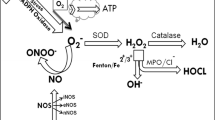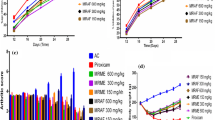Abstract
Elevated free radical generation in inflamed joints and impaired antioxidant system has been implicated in rheumatoid arthritis (RA). Green tea extracts (GTE) have been shown to reduce inflammation in inflammatory arthritis murine model. This study investigates possible mechanisms by which vitamin C and GTE protect joints in RA rat model. This study included forty adult male rats that were divided into four groups (10 rats each); control group, collagen II induced RA group (CII), CII treated with vitamin C (CII + Vit C) and CII treated with GTE (CII + GTE) in physiology laboratory, Assiut University, Egypt. After 45 days of treatment, plasma levels of lipid peroxides (LPO), nitric oxide (NO), ceruloplasmin (CP), superoxide dismutase (SOD), uric acid (UA) and glutathione (GSH) were detected using colorimetric methods, PGE2 using ELISA and copper (Cu) and zinc (Zn) using spectrometer. In CII group, levels of LPO, NO, PGE2, UA, CP, Cu were higher while SOD, GSH, Zn were lower than controls. In groups treated with vitamin C and GTE, levels of SOD, GSH were increased while levels of LPO, NO, PGE2, Cu, CP were decreased compared with CII group. Levels of UA were decreased and Zn increased in GTE treated group compared with CII group. GTE treated group showed higher Zn and low Cu levels compared with vitamin C treated group. This study suggests proper GTE and vitamin C intake may effectively normalize the impaired oxidant/antioxidant system and delaying complication of RA.
Similar content being viewed by others
References
Gabriel SE. The epidemiology of rheumatoid arthritis. Rheum Dis Clin North Am 2001;27:269–281.
Weyand CM, Goronzy JJ. Pathogenesis of rheumatoid arthritis. Med Clin North Am 1997;81(1):29–55.
Trentham DE, Townes AS, Kang AH. Autoimmunity to type II collagen an experimental model of arthritis. J Exp Med 1997;146:857–868.
Ozkan Y, Yardym-Akaydyn S, Sepici A, Keskin E, Sepici V, Simsek B. Oxidative status in rheumatoid arthritis. Clin Rheumatol 2007;26(1):64–68.
Emery P. Clinical implications of selective cyclooxygenase-2 inhibition. Scand J Rheumatol 1996; 102(Suppl): 23–28.
Milanino R, Moretti U, Concari M, Marrella M, Velo GP. Copper and zinc status in adjuvant arthritic rat: studies on blood, liver, kidneys, spleen and inflamed paws. Agents Actions 1988;24:365–376.
Kremer JM, Bigaoutte J. Nutrient intake of patients with rheumatoid arthritis is deficient in pyridoxine, zinc, copper, and magnesium. J Rheumatol 1996;23:990–994.
Tuncer S, Kamanli A, Akcil E, Kavas GO, Seckin B, Atay MB. Trace element and magnesium levels and superoxide dismutase activity in rheumatoid arthritis. Biol Trace Elem Res 1999;68(2):137–142.
Shimizu M, Weinstein IB. Modulation of signal transduction by tea catechins and related phytochemicals. Mutat Res 2005;591:147–160.
Haqqi TM, Anthony DD, Gupta S, Ahmad N, Lee MS, Kumar GK, Mukhtar H. Prevention of collagen-induced arthritis in mice by a polyphenolic fraction from green tea. Proc Natl Acad Sci USA 1999;96:4524–4529.
Ahmed S, Rahman A, Hasnain A, Lalonde M, Goldberg VM, Haqqi TM. Green tea polyphenol epigallocatechin-3-gallate inhibits the IL-1beta induced activity and expression of cyclooxygenase-2 and nitric oxide synthase-2 in human chondrocytes. Free Radic Biol Med 2002;33:1097–1105.
Mohamadin A., El-Beshbishy H, El-Mahdy M. Green tea extract attenuates cyclosporine A-induced oxidative stress in rats. Pharm Res 2005;51:51–57.
Polidori MC, Mecocci P, Levine M, Frei B. Short-term and long-term vitamin C supplementation in humans dosedependently increases the resistance of plasma to ex vivo lipid peroxidation. Arch Biochem Biophys 2004;423:109–115.
Mahajan A, Tandon VR. Antioxidants and rheumatoid arthritis. J Ind Rheumatol Assoc 2004;12:139–142.
Hegen M, Gaeste M, Telliez JB. MAPKAP Kinase 2-deficiencent mice are resistant to collagen-induced arthritis. J Immunol 2006;177:1913–1917.
Eldin AA, Hamdy MA, Shaheen AA, Motawi TK, Abd el Gawad HM. Effect of vitamin C administration in modulating some biochemical changes in arthritic rats. Pharmacol Res 1992;26(4):357–366.
Maity S, Vadasiromoni J, Ganguly D. Role of glutathione in the anti ulcer effect of hot water extract of black tea. Jpn J Pharmacol 1998;78:285–292.
Thayer WS. Serum lipid peroxides in rats treated chronically with adiramycin. Biochem Pharmacol 1985;33(14):2259–2263.
Van Beezooijen RL, QUE I, Ederveen AG, Kloosterbor HJ. Plasma nitrate + nitrite level are regulated by ovarian steroids but do not correlate with trabecular bone mineral density in rats. J Endocrinol 1988;159:27–34.
Ellman GL. Tissue sulfhydryl groups. Archives Biochem Biophys 1959;82:70–77.
Misra HP, Fridovich I. The generation of superoxide radical during the autoxidation of hemoglobin. J Biol Chem 1972;247(21):6960–6962.
Houchin OB. Quoted in: Practical Clinical Enzymology. King J, (ed). Van Nostrand Company London — 1177, Clin Chem 1959;4:519–523.
Fossati P, Prencipe L, Berti G. Use of 3,5-dichloro-2-hydroxybenzenesulfonic acid/4-aminophenazone chromogenic system in direct enzymic assay of uric acid in serum and urine. Clin Chem 1980;26(2):227–231.
Fermor B, Christensen SE, Youn I, Cernanec JM, Davies CM, Weinberg JB. Oxygen, nitric oxide and articular cartilage. Eur Cell Mater 2007;13:56–65.
Clancy RM, Amin AR, Abramson SB. The role of nitric oxide in inflammation and immunity. Arthritis Rheum 1998;41:1141–1151.
Noyota K, Jovanovic DV, Reboul P, Pelletier JM, Mineau F, Pelletier JP. The induction of cell death in human osteoarthritis chondrocytes by nitric oxide is related to the production of prostaglandin E2 via the induction of cyclooxygenase-2. J Immunol 2000;165:3402–3410.
Morgan SL, Anderson AM, Hood SM, Matthews PA, Lee JY, Alarcon GS. Nutrient intake patterns, body mass index and vitamin levels in patients with rheumatoid arthritis. Arthritis Care Res 1997;10:9–17.
Crespy V, Williamson G. A Review of the Health Effects of Green Tea Catechins in In Vivo Animal Models. J Nutr 2004;134:3431S–3440S.
Rennie KL, Hughes J, Lang R, Jebb SA. Nutritional management of rheumatoid arthritis: a review of the evidence. J Hum Nutr Diet 2003;16(2):97–109.
Thabrew MI, Senaratna L, Samarawickrema N, Munasinghe C. Antioxidant potential of two polyherbal preparations used in Ayurveda for the treatment of rheumatoid arthritis. J Ethnopharmacol 2001;76:285–291.
Singh R, Ahmed S, Malemud CJ, Goldberg VM, Haqqi TM. Epigallocatechin-3-gallate selectively inhibits interleukin-1beta-induced activation of mitogen activated protein kinase subgroup c-Jun N-terminal kinase in human osteoarthritis chondrocytes. J Orthop Res 2003;21:102–109.
Hou DX, Masuzaki S, Hashimoto F, Uto T, Tanigawa S, Fujii M, Sakata Y. Green tea proanthocyanidins inhibit cyclooxygenase-2 expression in LPS-activated mouse macrophages: Molecular mechanisms and structure-activity relationship. Arch Biochem Biophys 2007;460:67–74.
Fogel-Petrovic M, Long JA, Knight DA, Thompson PJ, Upham JW. Activated human dendritic cells express inducible cyclo-oxygenase and synthesize prostaglandin E2 but not prostaglandin D2. Immunological Cell Biol 2004;82:47–54.
Song DU, Jung YD, Chay KO, Chung MA, Lee KH, Yang SY, Shin BA, Ahn BW. Effect of drinking green tea on ageassociated accumulation of maillard-type fluorescence carbonyl groups in rat aortic and skin collagen. Arch Biochem Biophys 2002;397:424–429.
Vijayakumar D, Suresh K, Manoharan S. Lipid peroxidation of antioxidant status in blood of rheumatoid arthritis patients. Ind J Clin Biochem 2006;21(1):104–108.
Kiziltunc A, Cogalgil S, Cerrahoglu L. Carnitine and antioxidants levels in patients with rheumatoid arthritis. Scand J Rheumatol 1998;27:441–445.
Zoli A, Altomonte L, Caricchio R, Galossi A, Mirone L, Ruffini MP, Magaro M. Serum zinc and copper in active rheumatoid arthritis: correlation with interleukin 1 beta and tumour necrosis factor alpha. Clin Rheumatol 1998;17:378–382.
Evans P, Halliwell B. Micronutrients: oxidant/antioxidant status. Br J Nutr 2001;85(2):S67–S74.
Honkanen V, Konttinen YT, Sorsa T, Hukkanen M, Kemppinen P, Santavirta S, Saari H, Westermarck T. Serum zinc, copper and selenium in rheumatoid arthritis. J Trace Elem Electrol Health Dis 1991;5(4):261–263.
Shenkin A. Trace elements and inflammatory response: implications for nutritional support. Nutrition 1995;11:110–115.
Naveh Y, Schapira D, Ravel Y, Geller E, Scharf Y. Zinc metabolism in rheumatoid arthritis: plasma and urinary zinc and relationship to disease activity. J Rheumatol 1997;24:643–646.
Ganesan N, Chegu H, Chandrasekaran AN. Effect of type II collagen treatment on the antioxidant status in immune tissues of adjuvant induced arthritic rats. Ind J Clin Biochem 2003;18(2):216–222.
Kraus A, Roth HP, Kirchgessner M. Influence of vitamin C, vitamin E and beta-carotene on the osmotic fragility and the primary antioxidant system of erythrocytes in zinc-deficient rats. Arch fur Tierernahrung 1997;50:257–269.
Miesel R, Zuber M. Elevated levels of xanthine oxidase in serum of patients with inflammatory and autoimmune rheumatic diseases. Inflammation 1993;17(5):551–561.
Nemeth I, Talosi G, Papp A, Boda D. Xanthine oxidase activation in mild gestational hypertension. Hypertens Pregnancy 2002;21(1):1–11.
Smolenska Z, Kaznowska Z, Zarowny D, Simmonds HA, Smolenski RT. Effect of methotrexate on blood purine and pyrimidine levels in patients with rheumatoid arthritis. Rheumatol 1999;38(10):997–1002.
Forrest CM, Harman G, McMillan RB, Rana C, Shaw S, Stone TW, Stoy N, Darlington LG. Purine modulation of cytokine release during diuretic therapy of rheumatoid arthritis. Nucleosides Nucleotides Nucleic Acids 2004;23(8–9):1107–1110.
Yardim-Akaydin S, Sepici A, Ozkan Y, Torun M, Simsek B, Sepici V. Oxidation of uric acid in rheumatoid arthritis: is allantoin a marker of oxidative stress. Free Radic Res 2004;38(6):623–628
Author information
Authors and Affiliations
Corresponding author
Rights and permissions
About this article
Cite this article
Meki, AR.M.A., Hamed, E.A. & Ezam, K.A. Effect of green tea extract and vitamin C on oxidant or antioxidant status of rheumatoid arthritis rat model. Indian J Clin Biochem 24, 280–287 (2009). https://doi.org/10.1007/s12291-009-0053-7
Published:
Issue Date:
DOI: https://doi.org/10.1007/s12291-009-0053-7




